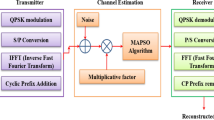Abstract
The detector applied to each single user based on adaline neural network (ANN) is presented in this paper, which is equivalent to the joint one applied to all users in eliminating the multiple access interference in CDMA systems. Then, particle swarm optimization (PSO) algorithm combined with least mean square scheme is employed in the training procedure of the ANN, which can effectively remove the shortcoming of the poor dynamic adaptive behavior of conventional neural network, i.e. during the convergence procedure of the weights in conventional neural network, the training samples are usually required to be trained iteratively. However, in the improved detector, each training sample can be trained repeatedly, so that the converging speed is getting much faster. Simulation results show that, in the ANN based multi-user detector improved by PSO, the dynamic adaptive behavior has been remarkably improved.
Similar content being viewed by others
References
Krajánák J., Deumal M., Pavelka P. (2008) Multi-user detection of nonlinearly distorted MC-CDMA symbols by microstatistic filtering. Wireless Personal Communications 47(2): 149–160
Yue X., Fan H. (2004) Near-far resistance of multicarrier CDMA communication systems. IEEE Signal Processing Letters 11(2): 212–215
Proakis J. G. (1989) Digital communications. McGraw-Hill, New York
Verdu S. (1986) Optimum multi-user asymptotic efficiency. IEEE Transactions on Communications 34(9): 890–897
Verdu S. (1989) Multiple-access channels with memory with and without frame synchronism. IEEE Transactions on Information Theory 35(3): 605–619
Yih C. (2007) MMSE multiuser receiver for uniformly quantized synchronous CDMA signals in AWGN channels. IEEE Communications Letters 11(9): 705–707
Hu C., Li S., Tang Y., Li Z. (2006) Performance and optimization of multistage partial parallel interference cancellation for wideband CDMA systems in multipath fading channels. IEEE Transactions on Vehicular Technology 55(4): 1137–1158
Ye H., Bar-Ness Y. (2004) Power-adaptation strategies for DS/CDMA communications with successive interference cancellation in Nakagami-fading channels. IEEE Transactions on Vehicular Technology 53(4): 1160–1166
Vorobyov S. (2008) Robust CDMA multiuser detectors: Probability-constrained versus the worst-case-based design. IEEE Signal Processing Letters 15(4): 273–276
Chuah T., Sharif B., Hinton R. (2002) Robust CDMA multiuser detection using a neural-network approach. IEEE Transactions on Neural Networks 13(10): 1532–1539
Shayesteh M., Amindavar H. (2003) Neural networks for multiuser detection of signals in DS/CDMA systems. Neural Computing and applications 11(2): 178–190
Shayesteh M., Amindavar H. (2003) Performance analysis of neural network detectors in DS/CDMA systems. AEU-International Journal of Electronics and Communications 57(3): 220–236
Soujeri E., Bilgekul H. (2003) Multiuser detection of synchronous MC-CDMA in multipath fading channels using hopfield neural networks. Neural Processing Letters 18(1): 49–63
Fantacci R., Mancini L., Marini M. (2003) A neural network-based blind multiuser receiver for DS-CDMA communication systems. Wireless Personal Communications 27: 195–213
Chen S., Samingan A., Hanzo L. (2005) Adaptive near minimum error rate training for neural networks with application to multiuser detection in CDMA communication systems. Signal Processing 85(11): 1435–1448
Liu X., Wang X., Wu Z. (2006) Modified hopfield neural network for CDMA multiuser detection. Advances in Neural Networks 39(1): 88–93
Li F., Zhao S., Zheng B. (2005) Quantum neural network for CDMA multi-user detection. Advances in Neural Networks 38(5): 338–342
Isik Y., Taspinar N. (2005) Parallel interference cancellation based on neural network in CDMA systems. IEICE Transactions on Communications 88((8): 800–806
Isik Y., Taspinar N. (2006) The multi-user detection in code division multiple access with adaptive neuro-fuzzy inference system. Journal of Information Science and Engineering 22(11): 1529–1542
Isik Y., Taspinar N. (2007) Multiuser detection with neural network and PIC in CDMA systems for AWGN and Rayleigh fading asynchronous channels. Wireless Personal Communications 43(10): 1185–1194
Karayiannis N., Chookiarti J. (2005) Regularized adaptive detectors for code-division multiple-access signals. IEEE Transactions on Wireless Communications 4(7): 1749–1758
Paris B., Aazhang B., Orsak G. (1992) Neural networks for multiuser detection in CDMA communications. IEEE Transactions on Communications 40(7): 1212–1222
Eberhart, R., & Kennedy, J. (1995). A new optimizer using particle swarm theory. Proceedings of 6th International Symposium on Micro Machine and Human Science, MHS (pp. 39–43). Nagoya: IEEE service center.
Kennedy, J., & Eberhart, J. (1995). Particle Sswarm optimization neural networks. IEEE ICNN, Piscataway, NJ.IEEE Service Center, pp.1942–1948
Yen K., Hanzo L. (2004) Genetic-algorithm-assisted multiuser detection in asynchronous CDMA communications. IEEE Transactions on Vehicular Technology 53(5): 1413–1422
Clerc, M. (1999). The swarm and the queen: Towards a deterministic and adaptive particle swarm optimization. Proceedings of the Congress of Evolutionary Computation (pp. 1951–1957) CEC, Washington DC.
Lovbjerg, M., Rasmussen, T., & Krink, T. (2001). Hybrid particle swarm optimizer with breeding and subpopulations. Proceedings of the 3rd Genetic and Evolutionary Computation Conference on machine learning and cybernetics. GECCMLC, pp. 2402–2405.
Author information
Authors and Affiliations
Corresponding author
Rights and permissions
About this article
Cite this article
Wang, J., Yang, H., Hu, X. et al. An Adaline Neural Network-Based Multi-User Detector Improved by Particle Swarm Optimization in CDMA Systems. Wireless Pers Commun 59, 191–203 (2011). https://doi.org/10.1007/s11277-009-9912-z
Published:
Issue Date:
DOI: https://doi.org/10.1007/s11277-009-9912-z




